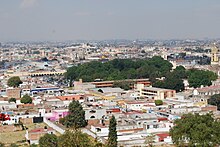San Pedro Cholula
The division of the city persisted and San Pedro remained the more dominant, with Spanish families moving onto that side and the rest of the population quickly becoming mestizo.
This side contains what is considered the center of the city, large plaza with several important buildings, including the San Gabriel monastery, facing it.
In the morning, this plaza of Cholula is filled with vendors selling typical street food, sweets and handcrafted toys for children.
[10] The San Pedro municipal palace is located behind this commercial area, occupying a space which was called the Xiuhcalli, (House of Turquoise), where a council of nobles met in the pre Hispanic era.
This museum was opened in 2001 after extensive restoration of the colonial era building by INAH, the city and the Universidad de las Américas-Puebla.
Three rooms display pre Hispanic artifacts, two contains colonial era items and one features a John O'Leary photographic exhibit of the city's religious festivals.
According to legend, Hernán Cortés promised to build one church here for every day of the year or for every pre Hispanic temple destroyed after the Cholula Massacre.
However, due to increases in the theft of religious art, many churches have implemented extra security measures and some have stopped opening during the week.
A second entrance in the atrium wall leads to this area, which may have been used for evangelization purposes and masses for the indigenous during the very early colonial period.
In three corners of the atrium, there are chapels, called "capillas posas", with pinnacle roofs, simple arches which are closed off by railing.
In 1986, the monastery agreed to let part of their building be renovated and converted into the Franciscan Library, done in cooperation with the Universidad de las Americas.
The façade has some Baroque elements, with its main entrance marked by a simple arch flanked by Corinthian columns and fluted pilasters.
[8][17] The various barrios or traditional urban neighborhoods and communities of the municipality have their own parish church dedicated to a patron saint, and some have more than this.
The older church building has a bell tower with pilasters and Salomonic columns on two levels, with an open cone (oculo) as a crest.
[8] The Mercado Municipal has managed to conserve the look of traditional Mexican markets, with women seated on the floor selling seeds, flowers, herbs, and more.
The decoration is based in paintings by Federico Silva and Gerardo Gomez Brito, various pieces done in local onyx and a number of antiques from various places in the world.
[4] The first human settlements of Cholula are on the San Andrés side of the city, dating somewhere between 500 and 200 BCE, during the middle Preclassic period.
It rapidly developed into an urban center in the Classic period (200-800 CE) dominating the Puebla-Tlaxcala region, growing to an area of about four km2 and a population of between 20,000 and 25,000.
[21] However, there is evidence of a change of dominant ethnicity, with a people known as the Olmec-Xicallana coming to power and pottery and other artifacts showing Gulf Coast influence.
The defeated group was pushed to the eastern half of the city with the new rulers living on the San Pedro side and constructing a new religious center, the Quetzalcoatl Temple to replace the Pyramid.
[8][21][24] The two parts of town were divided into encomiendas for a very short time, but in 1537 the entirety would be declared a city by the Spanish Crown, receiving its coat of arms in 1540.
Evidence of political distinctions can be found as early as 1548, but in 1714, the two halves were definitely separated when San Andrés was made an Indian Republic.
These barrios have their roots in the pre Hispanic period, but after the Conquest, the Spanish reorganized them around parish churches giving each a patron saint.
[1] Almost all of the oldest and most central neighborhoods of the city are in San Pedro and include, Tianguisnahuac, Calvario, Tlatempa, Mexicaltzingo, Xixitla and Tecama.
Here images of towns' and neighborhoods' patron saints are adorned with fruit, squash, chili peppers, corn and bread and presented.
Today, it is a procession inside the Capilla Real in which wooden crosses are handed out and a host offers food to visitors.
Principle crops include corn, beans, alfalfa, nopal cactus, onions, cilantro, radishes, cauliflower, cabbage, lettuce and cucumbers.
[14] This is what has made Cholula one of the better known destinations among foreign travelers to Mexico, as images of the pyramid with the church on top is often used for tourism promotion.
[4] San Pedro Cholula is located in the Valley of Puebla, which is a flat area bordered by the Sierra Nevada to the west, the La Malinche volcano to the north.
[17] The Zapotecas Mountain is important culturally as well, figuring in a number of local myths and legends, including one about a man who made a pact with a demon in order to obtain money to sponsor a religious festival.


